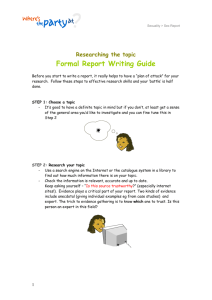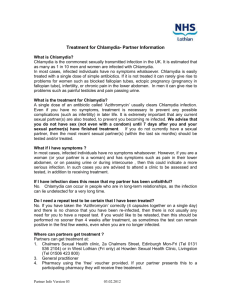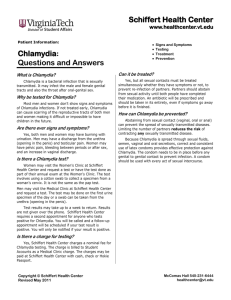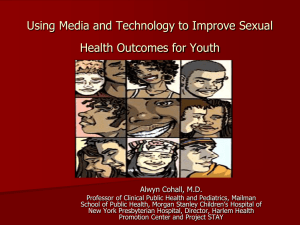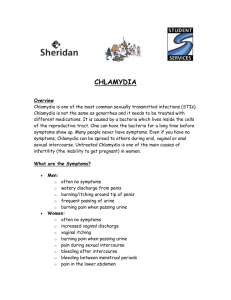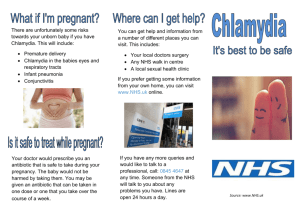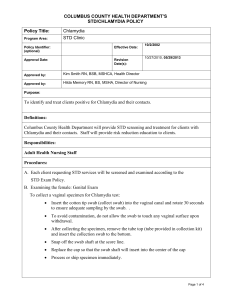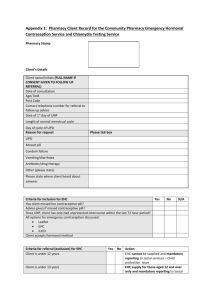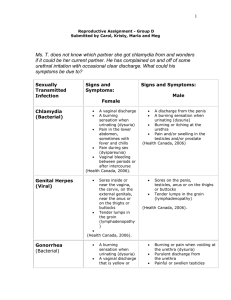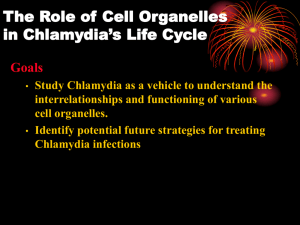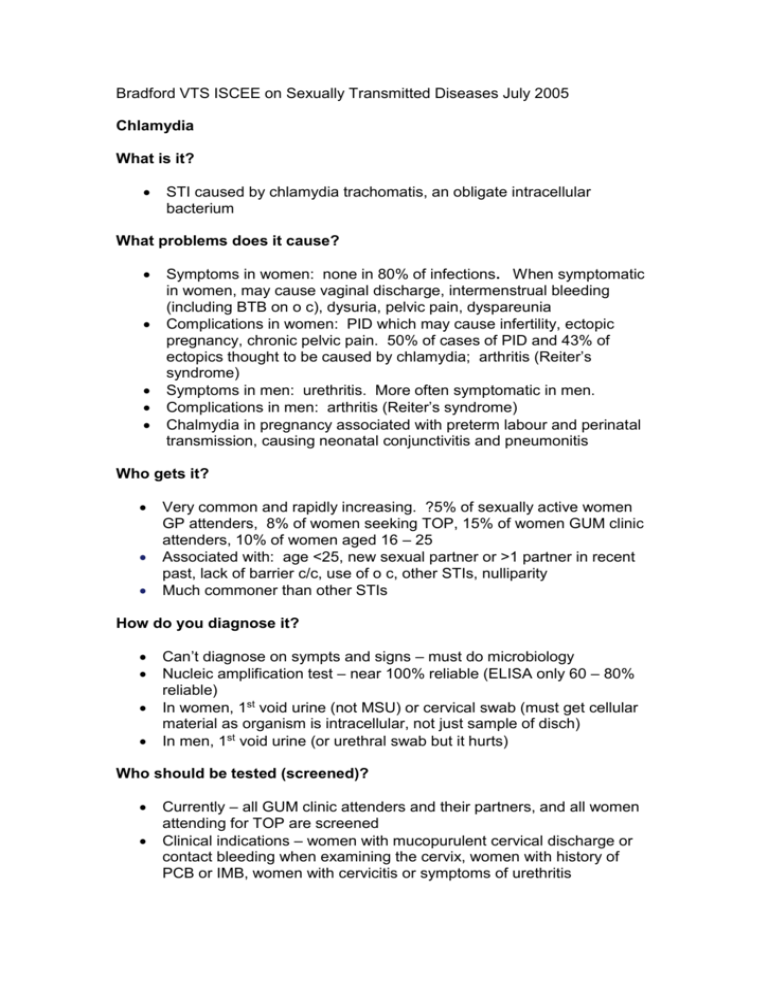
Bradford VTS ISCEE on Sexually Transmitted Diseases July 2005
Chlamydia
What is it?
STI caused by chlamydia trachomatis, an obligate intracellular
bacterium
What problems does it cause?
Symptoms in women: none in 80% of infections. When symptomatic
in women, may cause vaginal discharge, intermenstrual bleeding
(including BTB on o c), dysuria, pelvic pain, dyspareunia
Complications in women: PID which may cause infertility, ectopic
pregnancy, chronic pelvic pain. 50% of cases of PID and 43% of
ectopics thought to be caused by chlamydia; arthritis (Reiter’s
syndrome)
Symptoms in men: urethritis. More often symptomatic in men.
Complications in men: arthritis (Reiter’s syndrome)
Chalmydia in pregnancy associated with preterm labour and perinatal
transmission, causing neonatal conjunctivitis and pneumonitis
Who gets it?
Very common and rapidly increasing. ?5% of sexually active women
GP attenders, 8% of women seeking TOP, 15% of women GUM clinic
attenders, 10% of women aged 16 – 25
Associated with: age <25, new sexual partner or >1 partner in recent
past, lack of barrier c/c, use of o c, other STIs, nulliparity
Much commoner than other STIs
How do you diagnose it?
Can’t diagnose on sympts and signs – must do microbiology
Nucleic amplification test – near 100% reliable (ELISA only 60 – 80%
reliable)
In women, 1st void urine (not MSU) or cervical swab (must get cellular
material as organism is intracellular, not just sample of disch)
In men, 1st void urine (or urethral swab but it hurts)
Who should be tested (screened)?
Currently – all GUM clinic attenders and their partners, and all women
attending for TOP are screened
Clinical indications – women with mucopurulent cervical discharge or
contact bleeding when examining the cervix, women with history of
PCB or IMB, women with cervicitis or symptoms of urethritis
Proposed screening programme –all sexually active women under 25
and all older women with >2 partners in past 12 months.
This probably only needs to be women with male partners
The more tests you do, the more chlamydia you find. Must get informed
consent before testing!
Management
Referral to GUM clinic (possibly GPwSI clinic in some PCTs)
recommended for all positive results
Tracing and treating partners very important indeed
Realistic policy essential for patients who won’t attend GUM clinic: you
may need to treat, screen for other STIs and try to get partner(s)
treated, as GUM clinic would
1st choice treatment: Doxycycline 100mgs bd for 7d, or azithromycin
1g single dose
In pregnancy and breastfeeding: Erythromycin 500mgs qds for 7d
Follow up recommended after 2-3w but repeat investigation not
necessary if treatment has been complied with – only worth doing for
reassurance (but don’t do PCR until 3w after start of Rx as you can get
false positives earlier than this)
Undiagnosed urethritis in men (i e you don’t think they’d even come
back to you for results, let alone turn up at GUM clinic): try to cover
poss chlamydia and GC: Ofloxacin 200mgs bd or 400mgs od for 7d
Suspected PID due to chlamydia – usually admitted for IV antibiotics
but recommended regimens cover chlamydia, GC and anaerobes, e g
ofloxacin and metronidazole
Prognosis
Re infection is common
UK study under way, to decide optimum screening interval
More information
Chlamydia articles in www.gpnotebook.co.uk and fpnotebook.com (US
Family Practice equivalent to GP notebook site)
Prodigy guidance on chlamydia on www.prodigy.nhs.uk
4th Bandolier conference on chlamydia on www.jr2.ox.ac.uk/bandolier
PILS leaflets (Chlamydia in Women and Non Gonococcal
Urethritis/NGU) via MENTOR or from www.patient.co.uk

